Letters from Lodi
An insightful and objective look at viticulture and winemaking from the Lodi
Appellation and the growers and vintners behind these crafts. Told from the
perspective of multi-award winning wine journalist, Randy Caparoso.
A new (or is it old?) definition of wine balance
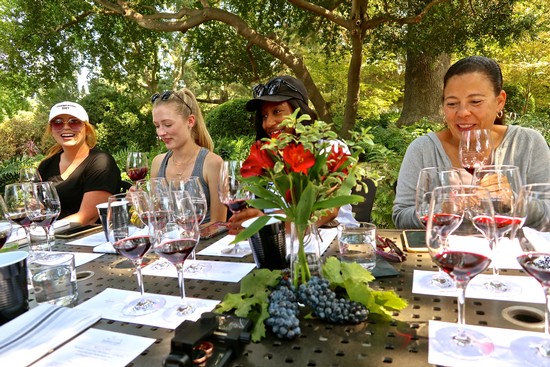
Popular wine influencers learn about Lodi Zinfandel by tasting them "blind" (from left, Casleah Herwaldt, Lexi Stephens, Desiree Harrison-Brown, and Jamie Knee).
A wine can be described as "balanced" when all its sensory qualities are in harmony, without an excess of one element or another. That is to say: Acidity is balanced when a wine is neither too puckery nor so soft that it lacks freshness or crispness. Tannin is balanced when the wine is not unpleasantly bitter or astringent. The body is in balance when alcohol does not taste harsh or hot. Aromatic qualities — such as oak, herbiness, or fruitiness — are all subjective to a beholder's ability to perceive them, which depends upon the volume of a person's "taste memory," as the late Michael Broadbent MW famously put it.
After that, all bets are off, because what may seem like a balanced wine to one person may be rough and excessive to another person, or weak and wimpy to still another person. There is absolutely no accounting for taste. Never has been, never will be.
California vs. French standards
Take, for example, the famous "Judgement of Paris" of 1976: Where French judges, in a blind tasting, were "fooled" into rating California wines above a few all-time great French growths, mostly because these judges had no prior experience of California wines. The official results of that historic tasting:
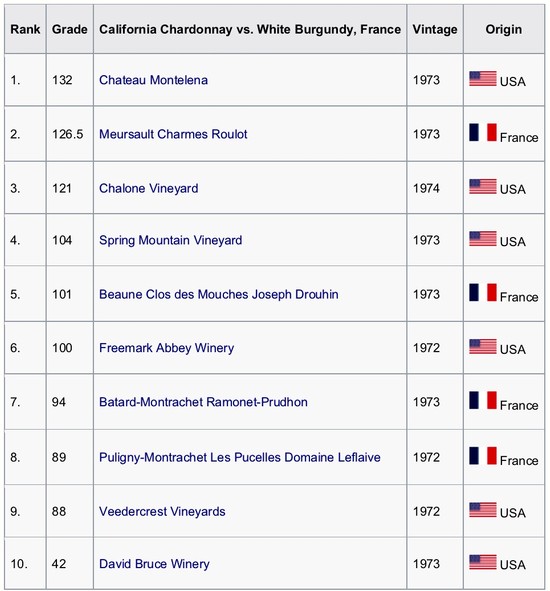
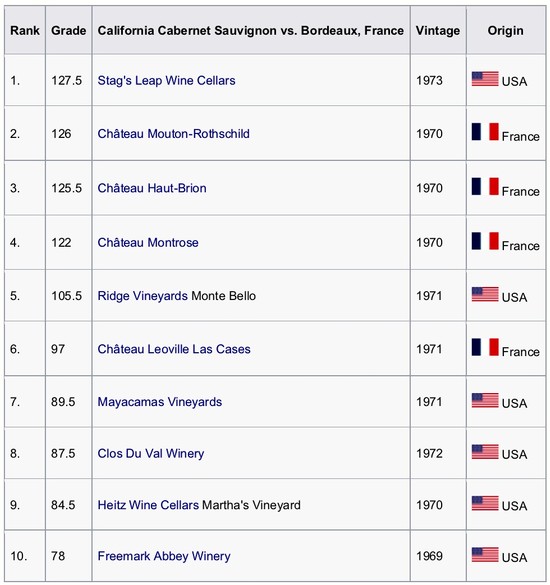
How could French judges possibly rate California wines higher than their own French wines? It happened because...
1. With no point of reference, which often happens in blind tastings involving inexperienced judges, the French judges ended up awarding the most points to wines that exhibited the most intense fruit character. Their assumption, obviously, was that France grows the best wines. Therefore, if a wine is intense in fruit, it is probably French. For the most part, they were wrong.
2. French wines were at a disadvantage in the Paris judging because sensory qualities such as subtlety, the harmony of sensations rather than intensity, and normally distinct, hallmark flavor markers commonly associated with French vineyards or terroir suddenly became blurred within this blind-tasting format. Once the judges fell into the trap of assuming that intensity should be their predominant standard of judgment, the distinctions that make French wines French suddenly became less important. In other words, they ended up rating the wines mostly by California standards, which put the French wines — particularly with respect to the Chardonnay-based white wines — on the wrong end of the stick.
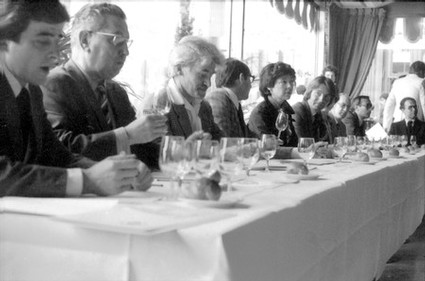
French experts during the 1976 "Judgement of Paris."
Given what they know now, would a comparable panel of French judges come up with the same ratings with a comparable lineup of wines today? The answer is: of course not. Even your average French wine professional now knows the fundamental differences between French and American wines. This is why these blind tastings are no longer done. There are obvious sensory distinctions that differentiate a California wine from a French; and now that these distinctions are known, comparisons are neither here nor there.
Or as Joe Heitz suggested way back when, in a 1976 book entitled Great Winemakers of California: "The best California wines are made in California, and the best French wines come from France."
The lesson that we all learned back then is that "balance" as the standard of wine judgment is, in fact, a slippery slope. It doesn't exist — which is why you will always be wrong when you begin to make assumptions about what a "balanced" wine entails.
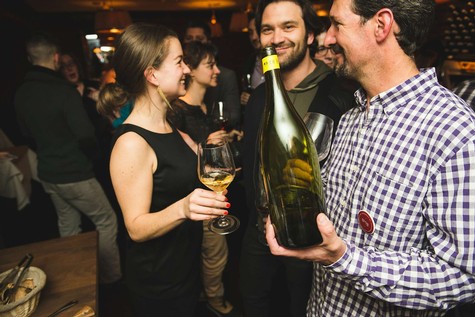
"In Pursuit of Balance tasting." San Francisco Chronicle.
"In Pursuit of Balance" vs. Terroir
If anything, the only arbiters of "balance" are wine consumers. If a consumer says a super-sweet, soft, fluffy, 6% alcohol wine is well-balanced, it's a balanced wine. If a consumer says a super-tart, desert dry, 12% alcohol wine is perfectly balanced, it's perfectly balanced. If another consumer says a 16% alcohol, super-oaky, high tannin wine is balanced, it's a balanced wine
As an illustration of that, let's go back to a more recent history — the last time "balance" became a major topic of discussion, at least within the California wine industry. In 2011 an organization was started, consisting of vintners and wine professionals who collectively called themselves "In Pursuit of Balance." This loose-knit organization lasted only five years — a blink of an eye, in terms of wine history — mostly because its message began to lose its punch.

Robert M. Parker Jr., the famous publisher of The Wine Advocate magazine popularized 100-point scores reflecting a predominant consumer preference for fuller-bodied wines with elevated fruit intensity.
What happened? Once the question of "balance" was loudly and publicly broached, it caused a lot of people in the industry, plus the media and consumers paying attention to it, to start to take sides — especially on the matter of whether or not wines that are over 14% alcohol, or picked at higher degrees of ripeness, are less desirable, or less “balanced,” than wines picked at lower sugars and finished closer to 12% or 13% alcohol. In other words, this group made a judgment call, that higher alcohol, ultra-ripe wines are not as well balanced. But not everyone agreed.
That "everyone" included the only group that matters: consumers. The fact is, the vast majority of mainstream American wines (i.e., varietals such as Chardonnay, Cabernet Sauvignon, Pinot Noir, Merlot, etc.) are, in fact, easily over 14% alcohol. Why? Because the vast majority of consumers prefer them that way. Most American consumers like "ripe fruit" qualities and a full body.
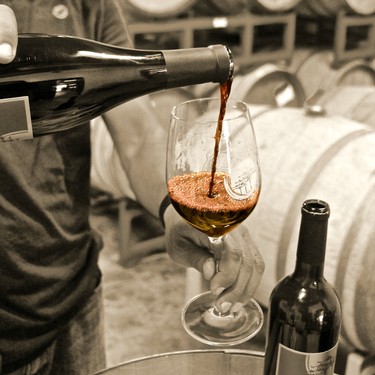
A glass of Petite Sirah, a California varietal rapidly growing in popularity because of its penchant for personifying the big, dark, fruit-driven style of wine appealing to many of today's consumers.
As much as in response to this predominant taste, or as a reflection of that preference, the wine media has a tendency to award the highest points to wines that are over 14%, and wines that express "gobs" of fruit or "hedonistic" levels of fruit intensity. This is not to mention the fact that the wine media's preferred way of rating wines, based on 100 points, is generally skewed towards a thought process in which "more is better." The fuller and fruitier the wine, the more points are awarded; and the more points awarded, the easier it is to sell the wine.
At that time I had personally shared my own opinion with colleagues, many of them longtime friends, who happened to be on the Pursuit of Balance bandwagon: That the biggest problem was the fact that their energies were probably directed in the wrong place. Instead of advocating for arbitrary definitions of "balance" (in terms of levels of alcohol and fruitiness), they might be better off arguing for more useful definitions of balance — definitions having to do with the way the best wines of the world are actually grown and made.
The problem was not that American wines were too big or fruity, or that there is too much emphasis placed on "more-is-better" standardization when wines are rated. The problem was that they were talking about wines as they were all the same and that they should all meet one definition of "balance."
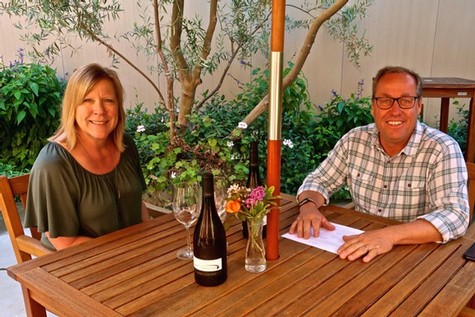
Jorja and Kyle Lerner of Lodi's Harney Lane Winery, now produce two styles of Chardonnay to appeal to two different tastes: a barrel fermented estate bottling for lovers of fuller-bodied "buttery" styles, and a Scottsdale Vineyard Chardonnay for the growing number of consumers looking for crisper, more minerally, less obviously fruited, terroir-focused styles.
But wines are not all the same, and the biggest reason for that is because they are grown in so many different places. If you want to talk about a "sense of balance," the only legitimate way of talking about it is in terms of the basic premise of what we call terroir: The idea, in the simplest way of putting it, that the best possible wines are those that meet the expectations depending on where it's grown. Or, as terroir is commonly defined, in terms of how successful a wine is at capturing a "sense of place" in its sensory profile.
The idea is that wines from each place have their own definitions of a "sense of balance," and therefore, no one place should define what that balance should be for all the other places.
There is a reason, for instance, why California wines are fuller-bodied and generally riper in fruit than, say, French wines: It is because there is more sun in California. Most California wine regions are defined by a Mediterranean climate, which means completely dry, rain-free growing seasons. Of course, comparable French wines — from Bordeaux, Burgundy, the Loire, etc.— are lower in alcohol, higher in acidity, and earthier or minerally rather than fruit-driven in character. They grow under much less sun!
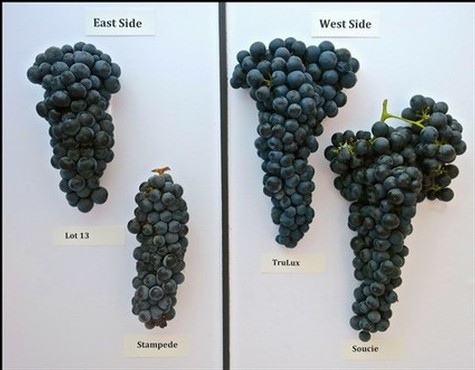
Comparison of typical Zinfandel clusters grown on Lodi's east (left) and west (right) sides, resulting from differences in terroir, leading to different styles of wine.
Therefore, it is perfectly reasonable, even preferable, for a California wine to be full-bodied, rounder in texture, and intense in fruit. That is, the fruitier the better. The California sun is conducive to that.
By the same token, the most absurd thing anyone could ever do is expect a wine from, say, Texas, Canada, or anywhere from Mexico, South America, Australia, New Zealand, or South Africa to be grown and produced in a way that can be comparable to a California wine. Or a French wine. Just here in California, we know that Sonoma's Dry Creek Valley makes a much different style of Zinfandel from that of Lodi and Amador County. Here in Lodi, it's become silly to compare a Zinfandel grown on the west side of town to a Zinfandel grown just a few miles away on the east side. The terroir is different, the vineyards make different styles of wine, and therefore the wines' sense of "balance" is different.
I would also remind you of this basic tenet that all of us wine geeks learn when we first start studying wine: The entire point of European classification systems, such as France's appellation origin contrôlée, is to delineate regions, not to delineate wines in terms of style, or even the grapes they are made from. To the French, as counter-intuitive as it may seem to most Americans, "varietal character" means nothing. Fruit intensity, or even different manifestations of fruit expression, are neither here nor there. Fruit character means even less than sensory attributes associated with individual brands or houses, despite the fact that the French do celebrate their best winemakers and appreciate them as artists.
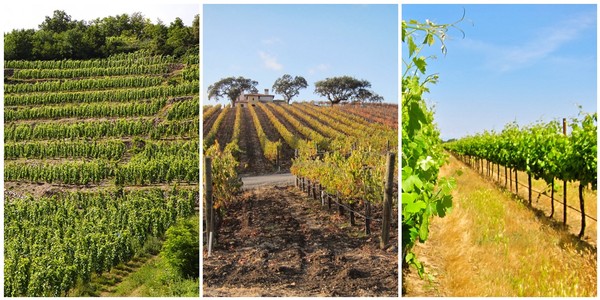
Syrah vineyards in France's Cornas appellation (left), Santa Barbara's Ballard Canyon AVA (middle), and Lodi's Mokelumne River AVA (right), each producing unique styles of wine because of their dramatically different terroirs.
This is why, for instance, red wines from France's Cornas appellation are never crafted to taste like red wines from Côte-Rôtie, and Côte-Rôtie is never expected to resemble a Saint-Joseph, Hermitage, or Crozes-Hermitage, even though all of these appellations are in the Northern Rhône Valley and made from the same grape, Syrah. The whole point of an appellation system is for wines to achieve sensory distinctions based on where they are grown, not how they are made or even judged. A Cornas is highly rated when it achieves a sense of balance appropriate for Cornas, not for that of Côte-Rôtie or Saint-Joseph.
"Balance," in this much older sense, is a concept defined by terroir, less so by growers and winemakers, and even less so by the grapes that are utilized. So if certain vineyards, planted to certain grapes under different circumstances, produce wines that are, say, higher or lower in color, higher or lower in tannin, higher or lower in acidity or alcohol, or even higher or lower in terms of oak influence, then it is these unique sets of circumstances that define the ideal sensory profiles. "Balance," by this definition, is an entirely flexible construct. It depends on where a wine is grown, not how it compares to other wines.
Needless to say, here in the U.S., for the most part, we have a very poor idea of what would be considered a balanced wine in each of our regions, simply because we are only just beginning to understand our regions. But that does not nullify the fundamental truth that has long been known, and considered basic common sense, in wine regions far older than ours: That notions of sensory balance are determined by where wines are grown.
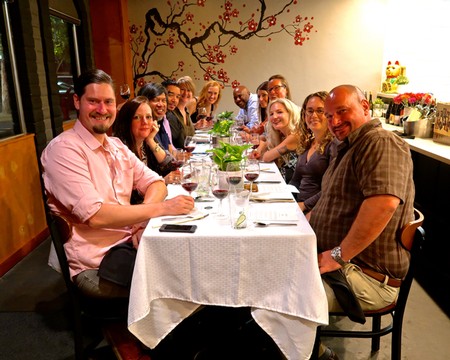
Visiting sommeliers experiencing the multiplicity of Lodi wines in the context of multi-cultural cuisine at M Sushi Bistro.
Popular vs. emerging "natural" styles
Right now, the wines that we find mostly in our grocery stores or big box stores are, in fact, full-bodied, fruit-driven wines.
America's biggest market segments are still in the areas of fuller-bodied, fruit-driven wines. This is because, according to the latest statistics, more than 60% of all wine sold is grown and produced in California. Most of the California wines sold are designed to meet exactly what the average consumer expects out of them. A White Zinfandel and Moscato, for instance, should be light, fruity, and sweet. Cabernet Sauvignons is much dryer and heavier. Pinot Noirs, dry yet softer, more fragrant. Pinot Grigios and Sauvignon Blancs, lemony tart and dry. Chardonnays are fuller-bodied yet "buttery" soft, and rounded.
There is, however, a tiny yet growing movement of "handcraft" style wineries or brands that are finding more and more commercial success by going the opposite direction — producing wines that are less predictable, sometimes achieving profiles or a "sense of balance" that are the opposite of wines made in mainstream styles.
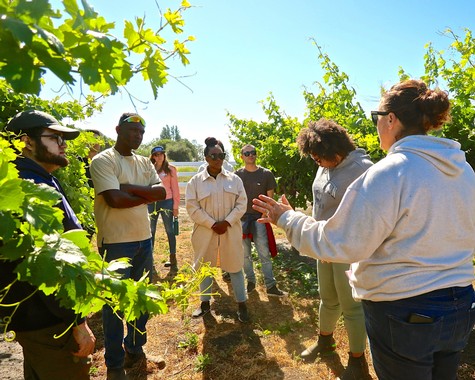
Visiting wine industry scholars learning about the significance of "Certified Green" winegrowing at Kolber Ranch, in the Delta region of the Lodi AVA.
Some of these small, handcraft producers are even exploring a niche that most of the wine industry still considers something of a swear word — they are exploring so-called "natural" wines. Not so many wines are made sulfur-free, but rather wines that are native yeast fermented, generally unfiltered, and handcrafted with minimal input. Less scrupulous marketers are even calling this "clean" wine. Marketers who are a little smarter are trumpeting the lower carbon footprint of these wines, especially when they are sustainably grown, as a way of appealing to the growing consumer concern over climate change.
The positive thing about this slow yet steady turn towards more "natural" or earth-friendly styles is that, when wines are made in this fashion, they are bound to express sensory characteristics reflecting vineyards or regions, not just the work of human hands. These wines tend to be more terroir-focused because you are also more likely to pick grapes lower in sugar and higher in acidity in order to execute low intervention wine production, which requires a minimalizing of potential issues such as microbial spoilage, oxidation, Brettanomyces, stuck fermentation, and so on.
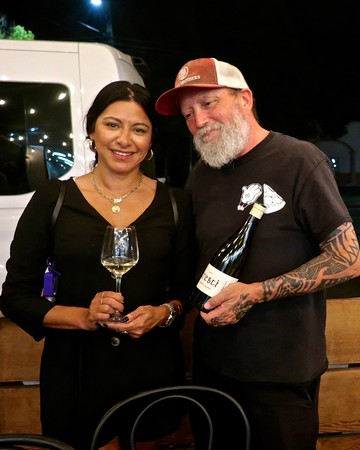
At a "natural style" wine event at Lodi's Guantonios Wood Fired, popular wine influencer Elle Rodriguez shares thoughts with Haarmeyer Wine Cellars winemaker/owner Craig Haarmeyer, known for zesty-edged, alternative-style wines.
When grapes are picked at lower sugars, they are also more likely to produce wines with less fruit expression, much less or no oak influence, yet possessing more mineral or earth-related sensations which, on an aroma/flavor level, can also be associated with a "sense of place." This is different from most commercial wines, which are based upon predictable fruit-related qualities (i.e., varietal character) and brand styles. In other words, wines crafted to meet new definitions of "balance" in order to be truer to terroir, rather than to achieve arbitrary notions of balance.
Yet these wines can be very original; mostly because when you let vineyards decide the direction of wine, the chances of that wine achieving a unique profile are increased simply by the fact that no two vineyards, or no two regions, are exactly the same.
This is, in fact, a more "European" approach to wine production — something that might be considered unconventional by predominant American standards, but is very much mainstream in terms of European traditions. What's new to most of us is an "old hat" across the pond.
The wine industry, after all, is really no different than any industry. As Americans, we like predictability, but we also appreciate originality. We like our products to be dependable, but we also want them to be new, exciting, innovative... different. And because no two vineyards are really alike, wine can be a perfect way to fulfill this basic, human longing for differentiation, and artistry. Artistry when it comes to wine, however, is defined as much (or more!) by vineyards as the people who farm them, which is what makes wine appreciation so much fun and interesting.
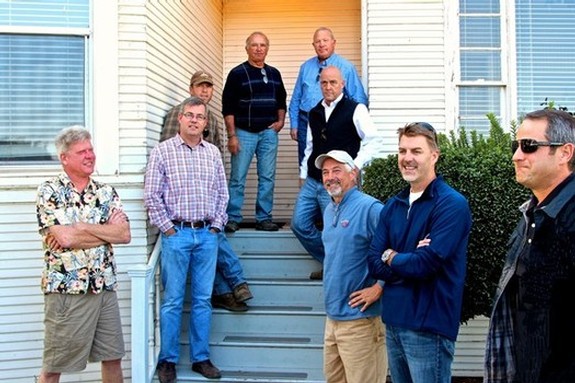
Winemakers and growers associated with the original "Lodi Native" movement, a group advocating minimal intervention, native yeast fermented Zinfandel crafted to differentiate vineyard qualities rather than brand profiles or varietal characteristics.